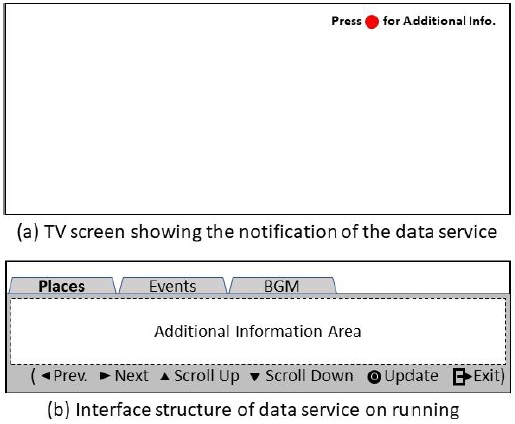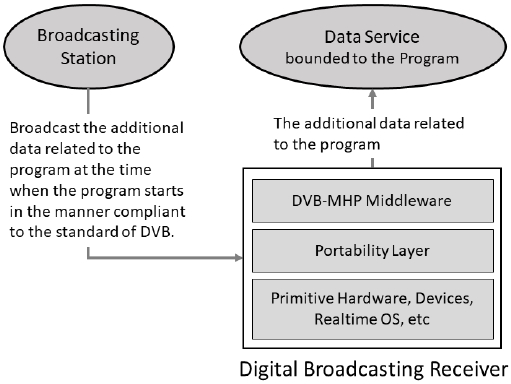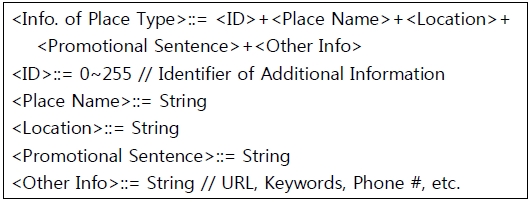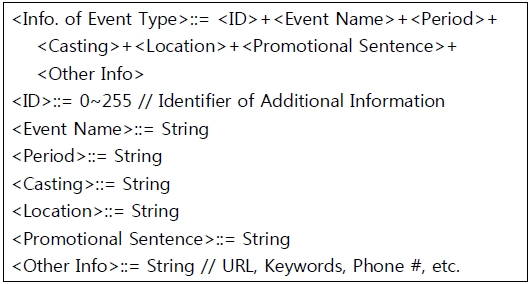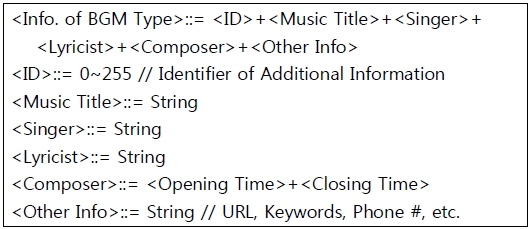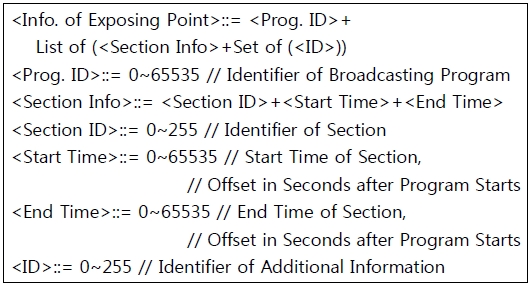
A study on The Data Service bounded to The Travel-Themed Broadcasting Program
Copyright ⓒ 2020 The Digital Contents Society
This is an Open Access article distributed under the terms of the Creative Commons Attribution Non-CommercialLicense(http://creativecommons.org/licenses/by-nc/3.0/) which permits unrestricted non-commercial use, distribution, and reproduction in any medium, provided the original work is properly cited.

Abstract
Through the analysis of big data on social media in 2018 and 2019, the Korea Tourism Organization suggested that visiting destinations introduced in broadcasting programs and the growing influence of video media on destination selection as the representative travel trends. In this background, broadcasters are producing various reality broadcasting programs based on travel. This study designed a broadcasting program bounded data service that helps viewers improve their intention to visit the travel destination by providing them with promotional and detailed information on travel places, travel area events and background musics introduced in the broadcasting program. Specifically, this study defined formally the typical types of additional information in a travel-themed broadcasting program and designed a method for distinguishing related additional information according to the contents of the broadcasting program. In addition, an international digital broadcasting standard DVB-based data transmission method was developed that supplies the additional information to the data service according to the broadcasting time of the broadcasting program.
초록
한국관광공사는 2018년과 2019년도 소셜미디어의 빅데이터 분석을 통해 방송프로그램에 소개된 여행지를 방문하는 것과 여행지 선택 및 방문 기록에 영상미디어의 영향력이 커지고 있는 것을 대표적인 여행 트렌드로 제시하였다. 이런 배경 속에, 방송사는 여행을 소재로 한 다양한 리얼리티 방송프로그램 제작하고 있다. 본 연구는 여행 방송프로그램 시청자들에게 현재 방송프로그램에서 소개되는 여행 장소, 여행지역의 행사, 배경 음악 등의 홍보 및 상세 정보를 제공하여, 시청자들의 여행지 방문 의도 향상에 도움을 주는 방송프로그램 연동형 데이터 서비스를 설계하였다. 구체적으로, 여행 방송프로그램의 대표적인 부가정보의 유형을 정형적으로 정의하고, 방송프로그램 내용에 맞추어 연관된 부가정보를 구분하는 방법을 설계하였다. 그리고 부가정보를 방송프로그램의 방송 시간에 맞추어 데이터 서비스에 제공하는 국제 디지털방송 표준인 DVB 기반의 데이터 전송 방법을 개발하였다.
Keywords:
Travel-Themed Broadcasting Program, Visiting Intention, Data Service, Digital Broadcasting, DVB키워드:
여행 방송프로그램, 여행지 방문 의도, 데이터 서비스, 디지털방송, DVBⅠ. Introduction
1-1 Research Background
The Korea Tourism Organization presented S·T·A·R·T as the travel trend in 2018 through big-data analysis of social media such as blog, Facebook, YouTube, and Instagram [1]. Here, ‘T’ stands for ‘Tourist Sites in TV Programs,’ and indicates the tendency to visit regions introduced in dramas and travel programs. In 2019, the Korea Tourism Organization presented B·R·I·D·G·E as the travel trend, where ‘I’ stands for 'Influential Contents', which represents the trend of travelers who leave to the place they saw in the video and leave my record as a video [2].
In the travel trends of 2018 and 2019, it can be seen that broadcast programs or video contents of single-person media are becoming a facilitator that induces motivation for travel. As if responding to this phenomenon, broadcasters are increasing the number of broadcast programs on the subject of travel, and diversifying the types of broadcasting programs to increase viewers' interest in travel destinations. In particular, while broadcasting programs based on travel materials in the past were in the form of documentaries that provided information on travel destinations in a simple way, now broadcasting programs in the form of providing both information and entertainment are aired, and the format of a reality program that films performers' actions within a situation without a given script is mainly produced [3].
1-2 Related Works
In this background, various studies were conducted to analyze the effect of the travel-themed broadcasting program on the viewer's intention to visit the travel destination.
Yoon-Jae Nam (2018) analyzed the relationship between tourism/travel and broadcasting programs, and revealed that entertainment programs on tourism themes reflect travel trends, and sometimes lead the trend to trigger the development of tourism products[4]. Yea-jin Joo et al. (2018) surveyed visitors of the dark tourism, who tour the historical sites of sad history such as war. From the survey, it was revealed that viewing of liberal arts and news broadcast programs has an influence on educational motives, and viewing of news, reports, sports, games, and liberal arts programs has an influence on the motivation for general travel [5]. Kyung-Seop Cho et al. (2016) analyzed the effect of the reality overseas-travel-themed broadcasting programs on the travel destination selection, and found that the rational and emotional changes induced while watching the broadcasting program influence the travel destination selection and visit intention [6].
Yeong-Ah Lee (2017) analyzed the influence of the travel-themed broadcast programs on the public in the era of free travel and the factors that made these programs popular [7]. Sung-Hoon Kim et al. (2019) verified that the motivation of viewing reality travel-themed broadcasting programs positively influences the attitude toward the programs and the intention to visit the travel destination [3].
From the results of these researches, it can be seen that a travel-themed broadcasting program is an effective medium for increasing the intention to visit a travel destination for viewers.
1-3 Research Subject
This paper devised a travel-themed broadcasting program linked data service for the purpose of providing additional information on the travel destinations introduced in a broadcasting program.
Since this data service runs in conjunction with a travel-themed broadcasting program, it has the characteristic of reinforcing the viewer's desire to visit travel destinations triggered by the broadcasting program in a timely manner. In addition, since the viewer can execute and terminate the data service at any time while the running time of a broadcasting program, this data service provides a function of showing the information of the travel destination introduced in the broadcasting program at the time of executing the data service1). Specifically, this study designed the user interface of the data service linked to the broadcasting program by reflecting the characteristics of the TV platform, and the method of informing the data service of the point at which the additional information of the travel destinations should be exposed. We devised a method of supplying additional information of the broadcasting program to the data service in a way consistent with the international standard DVB (Digital Video Broadcasting) [9].
This study is meaningful in that it is a new attempt to enhance the viewer's intention to visit the travel destination by utilizing data services in conjunction with travel-themed broadcasting programs. It is hoped that this study will present new possibilities to revitalize the travel and tourism culture that has been eroded by the Corona 19 incident.
Ⅱ. Overview of Data Service
This data service is linked to the travel-themed broadcasting program and shows the viewers additional information related to the contents of the broadcasting program that changes every moment. In this study, the additional information of the travel-themed broadcasting program was defined as a place, an event, and background music, but various types of additional information can be added according to the request of a broadcaster or program provider.
A typical user scenario for this data service is as follow. When a broadcasting program linked with this data service starts, a notice indicating the existence and execution method of the data service is displayed on the upper right of the TV screen. When a viewer executes the data service, additional information on places, events, and/or background musics appearing in the broadcasting program is provided under the TV screen. Once output, the additional information is maintained until the viewer requests the additional information to be updated. If a viewer requests an update of additional information, it is changed to additional information of the places, events, and/or background musics that appear in the broadcasting program at that time. The data service is terminated when the viewer intentionally terminates, the linked broadcast program terminates, or tuned to another channel.
Figure 1 shows an example of a user interface that reflects the function of this data service. When watching a broadcasting program linked to the data service, a graphic indicating the existence and execution method of the data service is displayed on the upper right of the TV screen. When the viewer presses the red button on the remote controller, the data service is executed, and additional information shown currently in the broadcasting program is provided at the bottom of the TV screen by dividing it into place, event, and background music tabs. Viewers can select the tab to view additional information they want, and when new places, events, and background music appear in the broadcast program, they can update the additional information by pressing the <OK> button on the remote control. The viewer can terminate the data service at any time by pressing the <EXIT> button on the remote control. The interface of the data service is designed to have a depth of less than 3 levels without exceeding 1/3 of the TV screen based on the research in [10].
The data service in this study was designed based on DVB-MHP [11], an international standard for data broadcasting, and was designed to operate as an ‘embedded’ data service. An embedded data service is stored in advance in the digital broadcasting receivers, so it can be executed quickly and t additional information can be sensitively synchronized with the contents of broadcasting programs.
The additional information to be provided to viewers in the data service can be changed at any time according to the intention of the broadcaster or broadcast program provider. Therefore, this study separated the additional information from the data service without implementing the additional information in the data service code. That is, the data service is stored in the digital broadcasting receiver, but the additional information of the broadcasting program is transmitted to the data service according to the start time of the broadcasting program. (See Figure 2)
The design of such a data service should be accompanied by the following studies. (1) A method of informing the data service of which point of time the additional information of a broadcasting program should be exposed, and (2) a method of supplying the additional information of a broadcasting program to the data service in a way consistent with the international standard DVB. The subject of this study is dealt with in the following sections.
Ⅲ. Formal Definition of the Additional Information and Exposing Points
3-1 Additional Information Definition
This study largely categorizes the types of additional information of travel-themed broadcasting programs into ‘Place’ type, ‘Event’ type, and ‘Background Music’ type. In recent years, as the importance of background music has increased in travel-themed broadcasting programs, this study also included background music and songs as major additional information of travel-themed broadcasting programs. By defining the type of additional information in this way, the data service can efficiently process the additional information.
• Additional Information of Place Type
The additional information of Place type includes the information about places such as historic sites, museums, and parks that are exposed in the broadcasting programs. In this study, the additional information of Place type was defined as place name, location information, promotional text, and other information. Other information may include an Internet URL, a search keyword, or a representative phone number from which detailed information about a place can be obtained. (See Fig. 3)
Above, <ID> is an ID that uniquely identifies the additional information in the broadcasting program. <ID> is used for the same purpose for additional information of Event type and Background Music type.
• Additional Information of Event Type
The additional information of Event type includes the information about local festivals, cultural events, and performance events exposed in the broadcasting programs. In this study, the additional information of Event type was defined as event name, event period, cast members, location information, promotional text, and other information. In the case of the event, the information of the cast is highly important, so it was classified as a separate item. (See Fig. 4)
• Additional Information of Background Music Type
The additional information of Background Music type includes the information about music or song information exposed in the broadcasting program. In this study, the additional information of Background Music type was defined as music title and singer information, lyricist and composer information, and other information. Other information may include a description of the original song when the song currently being broadcast is remade. (See Fig. 5)
3-2 Exposing Points Definition
Travel-themed broadcasting programs have the property that the place to be visited continuously changes over time. For example, a program that introduced Jeju Island's travel course introduced a series of parks where you can enjoy non-powered carts. a snorkeling center, and a local restaurant. Therefore, in the data service, there must be a method of exposing additional information such as places, events, and music at an appropriate time according to the contents of the broadcast program. Therefore, the data service should have a method of exposing additional information, such as location, event, and background music, at an appropriate time, depending on the content of the broadcasting program. In this study, in order to divide the broadcast program into several sections and provide additional information according to the contents of the broadcast program in each section, the additional information exposure time information is formally defined as Fig. 6.
<Prog. ID> is the unique ID of the travel-themed broadcasting program managed by the broadcaster. <Section Info> is composed of <Section ID>, which can identify a specific section of the broadcasting program, and <Start Time> and <End Time> of the section period. <Start Time> and <End Time> are described as offsets in seconds from the start time of the broadcasting program. The set of <ID> is a collection of the additional information related to the places, events, and background musics exposed in the section designated by <Section Info>. Each <ID> is the same concept as the <ID> introduced in Section 3.1.
Ⅳ. Method for Transmitting Information
The SI (Service Information) of DVB [12], an international standard for digital broadcasting, is used to supply the data service with the additional information by type defined above and the exposure point information of the additional information. SI is a protocol for transmitting information necessary for channel management and electronic program guide (EPG), and defines various tables for transmitting the information of the broadcasting channels managed by broadcasters and the broadcast program information arranged in each broadcasting channel.
The SI table directly related to this study is an EIT-P (Event Information Table-Present) that transmits the information directly related to the currently aired broadcast program (eg program name, broadcast time, etc). Since EIT-P is repeatedly transmitted in a short period within 500ms, it is advantageous when transmitting information that needs to be sensitively synchronized at the start of a broadcasting program. All SI tables including EIT-P support the concept of ‘descriptor’ that can contain arbitrary information. This study defined the descriptors to transmit the additional information by type and the exposure point information of the additional information defined above. These descriptors are included in the EIT-P and transmitted to the data service.
Exposing_Point_Descriptor() contains information on the exposing point of additional information of a broadcast program, and is defined as shown in <Table 1>. The descriptor_tag, which is a descriptor identifier, has a value in the range of 0x80 to 0xFE to mean that it is a descriptor arbitrarily defined by the user. descriptor_length represents the size of the descriptor, and program_ID is an identifier of a broadcast program. section_ID is an identifier that uniquely identifies a section within a broadcast program (because it is 8 bits, one broadcast program can be distinguished into 256 sections), and start_time and end_time indicate when this section starts and ends from the start time of the broadcast program, respectively. They are expressed in seconds. In general, when considering that the length of a broadcast program is about 1 hour, if start_time and end_time are defined as 16 bits, the entire broadcasting program can be designated in seconds. Lastly, IDs are identifiers of descriptors that contain information about places, events, and background music exposed in this section.
Place_Info_Descriptor() contains the additional information of the Place type and is defined as in <Table 2>. The ID is an identifier of a descriptor that is uniquely distinguished within a broadcasting program, and thereafter, a place name, a place location, a promotional sentence, and other information are described as a character string.
Event_Info_Descriptor() contains the additional information of the Event type and is defined as shown in <Table 3>. It includes an ID that uniquely identifies this descriptor, and as event information, event name, event period, casting members, event location, promotional sentence, and other information can be described as a string. BGM_Info_Descriptor() contains the additional information of the Background Music type and is defined as in <Table 4>. It includes an ID that uniquely identifies this descriptor, and may describe music or song title, singer, lyricist, composer, and other information as a character string.
The data service can identify the places, events, and background music information exposed in a specific section of the broadcasting program from Exposing_Point_Descriptor(), and can extract the additional information to be displayed on the screen from the associated descriptors.
Ⅴ. Conclusion
The Korea Tourism Organization suggested that visiting travel destinations introduced in broadcasting programs is a representative travel trend through analysis of social media's big data in 2018 and 2019. Related studies have also announced the results that broadcasting programs have a positive effect on viewers' intentions to visit travel destinations introduced in broadcasting programs.
This study designed a data service operated in conjunction with a travel-themed broadcasting program with the aim of reinforcing the intention to visit the travel destination by providing more detailed information about the travel destination to the viewers immediately while watching the broadcasting program. Specifically, this study designed a user interface structure of a data service reflecting the characteristics of a TV platform, and defined formally the representative additional information of a travel-themed broadcasting program. In addition, the study defined the information for timely exposure of additional information related to the contents of a broadcasting program, and a method of supplying the information to a data service using a DVB-SI table.
This study is meaningful in that it suggests a direction that can be of little help to the travel industry stagnated by the Corona 19 incident through a new attempt of linkage between travel-themed broadcasting programs and data services. We also expect that the linkage with travel-themed broadcasting programs will develop into useful use of data services that cannot find any recognizable uses other than VOD services and EPG services.
Acknowledgments
This research is based on the support of 『2020 Woosong University Academic Research Funding』
Notes
References
- “Travel trend analysis using social media big data (2017~2018)”, Korea Tourism Organization, Dec. 2017
- “Social media big data utilization Domestic tourism trend analysis and 2019 trend forecast” , Korea Tourism Organization, Dec. 2018
- Sung-Hoon Kim, Do-Yoon Oh, Ha-Yeon Shin, “A Study on the Influence of the Motivation of the Reality Travel Program on the Viewing Satisfaction and Visiting Intention”, Journal of the Korea Contents Association, Vol. 19, No. 9, pp. 47-56, 2019
- Yoon-Jae Nam, “Tourism and Media Linkage - Focusing on the Use of Broadcasting Contents”, Korea Tourism Policy 2018 SUMMER, No. 72, 2018
-
Yea-Jin Joo and Yoon-Jae Nam, “The Cultivation Effect of Genre-Specific TV Programs on Dark Tourism Motivation and Satisfaction”, Journal of Tourilsm Sciences, Vol. 42, No. 10, pp. 191-214, 2018.
[https://doi.org/10.17086/JTS.2018.42.10.191.214]

- Kyoung-Seop Cho and Kie-Hyuk Shin, “The Effects of Reality Programming in the Selection of Tour Destinations for Foreign Travelers : Focused on the Show ‘Grandpa rather than Flowers’ (Taiwan)”, Northeast Asia Tourism Research, Vol. 12, No. 2, pp. 21-39, 2016
- Yeong-Ah Lee, “The opening of the era of free travel and the analysis of the success of travel TV programs”, International Journal of Glocal Culture, Vol. 6, No. 1, pp. 61-72, 2017
-
Kwangil KO, “A Method for Semantically binding a Data Service to a Broadcasting Program”, Journal of Digital Contents Society, Vol. 13, No. 4, pp. 539-545, 2012
[https://doi.org/10.9728/dcs.2012.13.4.539]

- “ETSI EN 301 192 v1.4.2: DVB specification for data broadcasting," ETSI, DVB, 2008.
-
Kwangil KO, “A Data Broadcasting Service Design Guideline based on the Survey on Viewer’s Modality of Using Data Broadcasting Services” The Journal of Korea Game Society, Vol. 12, No. 6, 2012.
[https://doi.org/10.7583/JKGS.2012.12.6.25]

- "Digital Video Broadcasting (DVB): Multimedia Home Platform (MHP) Specification 1.2“, ETSI, DVB, 2007.
- "Digital Video Broadcasting (DVB): Specification for Service Information (SI) in DVB systems,” ETSI, DVB, 2004.

1995년 : 포항공과대학교 전자계산학과 (학사, 석사)
1999년 : 포항공과대학교 컴퓨터공학과 (공학박사)
1999년~2010년 8월: (주)알티캐스트 사업품질관리본부 본부장 및 서비스개발사업팀 팀장
2010년 9월~현재: 우송대학교 테크노미디어융합학부 미디어디자인·영상전공 교수
※관심분야:디지털방송 소프트웨어, 스마트TV방송UI/UX, 소프트웨어공학, 요구분석공학, N-스크린 서비스, 소프트웨어 교육
